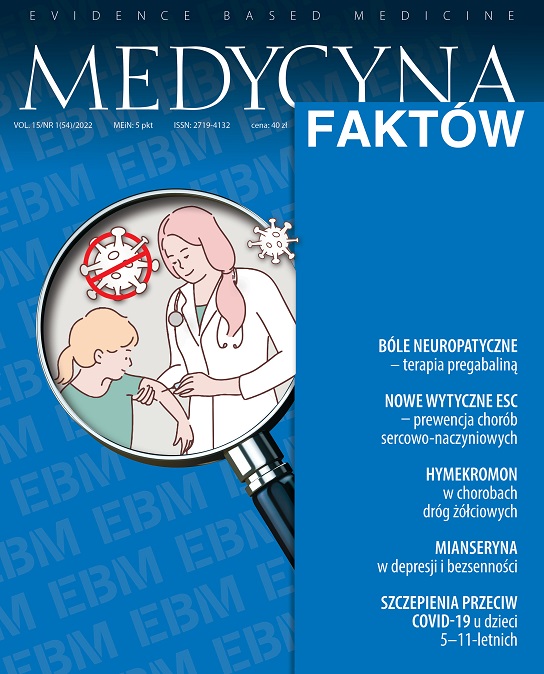COVID-19 vaccine in 5?11-year-old children, with particular focused on adverse events following immunization Review article
Main Article Content
Abstract
On December 10th, 2021, the Polish Minister of Health announced the beginning of vaccinations against COVID-19 in children aged 5?11. The introduction of vaccination against COVID-19 in people over 18 years of age and then 12 years of age has resulted that children aged 5?11 are the population with the highest incidence. Additionally, even after asymptomatic SARS-CoV-2 infection, children and adolescents are at risk of childhood multisystemic inflammatory syndrome. Vaccinations are the best form of prophylaxis. The vaccine developed by Pfizer/BioNTech (Comirnaty) in a pediatric dose of 10 ?g/dose (0.2 ml) is the only one approved for vaccination of children between 5 and 11 years of age. The vaccination schedule consists of two doses of the vaccine given 3 weeks apart. The estimated efficacy of this vaccine from 7 days after the second dose was 90.7%. The vaccine was well tolerated, and adverse events were mild and temporary. Local reactions (pain and redness at the injection site and swelling) were common and were mostly mild to moderate. The systemic events were mainly fatigue, headache, myalgia, chills, pyrexia, and arthralgia and were more frequent after the second dose. Drugs that are recommended in case of pain or fever are paracetamol and non-steroidal anti-inflammatory drugs. Currently, paracetamol is the drug of first choice. In conclusion serious adverse reactions to the vaccine against COVID-19 are rare, but patients should always be informed and prepared for. Each doctor is obliged to follow all new information and update recommendations.
Article Details
Copyright ? by Medical Education. All rights reserved.
References
2. Xue FX, Shen KL. COVID-19 in children and the importance of COVID-19 vaccination. World J Pediatr. 2021; 17(5): 462-6.
3. Orlińska I, Sybilski AJ. Jak dzieci chorują na COVID-19? Terapia. 2021; 1(396): 17-21.
4. Kao CM, Orenstein WA, Anderson EJ. The importance of advancing severe acute respiratory syndrome coronavirus 2 vaccines in children. Clin Infect Dis. 2021; 72: 515-8.
5. Hobbs CV, Drobeniuc J, Kittle T et al. Estimated SARS-CoV-2 seroprevalence among persons aged 18 years ? Mississippi, May-September 2020. MMWR Morb Mortal Wkly Rep. 2021; 70: 312-5.
6. Li Z, Guan X, Mao N et al. Antibody seroprevalence in the epicenter Wuhan, Hubei, and six selected provinces after containment of the first epidemic wave of COVID-19 in China. Lancet Reg Health West Pac. 2021; 8: 100094.
7. Loenenbach A, Markus I, Lehfeld AS et al. SARS-CoV-2 variant B.1.1.7 susceptibility and infectiousness of children and adults deduced from investigations of childcare centre outbreaks, Germany, 2021. Euro Surveill. 2021; 26: 2100433.
8. Misra P, Kant S, Guleria R et al. Serological prevalence of SARS-CoV-2 antibody among children and young age (between age 2-17 years) group in India: an interim result from a large multicentric population-based seroepidemiological study. medRxiv. 2021.
9. Tsabouri S, Makis A, Kosmeri C et al. Risk factors for severity in children with coronavirus disease 2019: a comprehensive literature review. Pediatr Clin North Am. 2021; 68: 321-38.
10. Preston LE, Chevinsky JR, Kompaniyets L et al. Characteristics and disease severity of US children and adolescents diagnosed with COVID-19. JAMA Netw Open. 2021; 4: e215298.
11. Sybilski AJ. Wieloukładowy zespół zapalny u dzieci okiem alergologa i immunologa. Alergol Pol ? Pol J Allergol. 2021; 8(4): 1-9.
12. Sybilski AJ. Wieloukładowy zespół zapalny u dzieci a COVID-19. Pediatr Med Rodz. 2020; 16(1): 125-6.
13. Duarte-Salles T, Vizcaya D, Pistillo A et al. Thirty-day outcomes of children and adolescents with COVID-19: An international experience. Pediatrics. 2021; 148(3): e2020042929.
14. Polack FP, Thomas SJ, Kitchin N et al. Safety and Efficacy of the BNT162b2 mRNA Covid-19 Vaccine. N Engl J Med. 2020; 383(27): 2603-15.
15. Baden LR, El Sahly HM, Brandon Essink B et al. Efficacy and Safety of the mRNA-1273 SARS-CoV-2 Vaccine. N Engl J Med. 2021; 384(5): 403-16.
16.Walter EB, Talaat KR, Sabharwal C et al. Evaluation of the BNT162b2 Covid-19 vaccine in children 5 to 11 years of age. N Engl J Med. 2021. http://doi.org/10.1056/NEJMoa2116298.
17. PZH. Czym są niepożądane odczyny poszczepienne? (access: 18.12.2021).
18. Rozporządzenie Ministra Zdrowia z dnia 31 grudnia 2020 roku zmieniające rozporządzenie w sprawie niepożądanych odczynów poszczepiennych oraz kryteriów ich rozpoznawania (t.j. Dz.U. z 2020 r. poz. 13).
19. Frenck RW Jr, Klein NP, Kitchin N et al. C4591001 Clinical Trial Group. Safety, immunogenicity, and efficacy of the BNT162b2 Covid-19 vaccine in adolescents. N Engl J Med. 2021; 385: 239-50.
20. Hause AM, Gee J, Baggs J et al. COVID-19 Vaccine Safety in Adolescents Aged 12-17 Years ? United States, December 14, 2020-July 16, 2021. MMWR Morb Mortal Wkly Rep. 2021; 70(31): 1053-8.
21. Recommendation on the use of the Pfizer-BioNTech COVID-19 vaccine (10 mcg) in children 5-11 years of age. Summary of the National Advisory Committee on Immunization (NACI) Statement of November 19, 2021 (access: 18.12.2021).
22. Rekomendacje Zespołu Ekspertów pod kierunkiem Konsultanta Krajowego w dziedzinie Alergologii dotyczące szczepienia przeciwko COVID-19 szczepionką mRNA (Comirnaty) dla Lekarzy kwalifikujących do szczepienia i dla Konsultantów Alergologów. Warszawa, 28.12.2020 rok.
23. Sybilski AJ. Niepożądane odczyny po szczepieniu przeciw COVID-19 ? jak postępować? Medycyna Faktów. 2021; 1(50): 6-10.
24. Etminan M, Sodhi M, Ganjizadeh-Zavareh S. Should Antipyretics be used to Relieve Acute Adverse Events Related to COVID-19 Vaccines? Chest. 2021; 159(6): 2171-2.
25.Doniec Z, Jackowska T, Sybilski A et al. GORĄCZKA u dzieci ? reKOMendacje PostępowaniA w praktyce lekarza podStawowej opieki zdrowotnej ? KOMPAS GORĄCZKA. Fam Med Prim Care Rev. 2021; 23(1). http://doi.org/10.5114/fmpcr.2021.102648.
26. Orlińska I, Sybilski AJ. Anafilaksja. Klin Pediatr. 2020; 28(1): 47-51.

